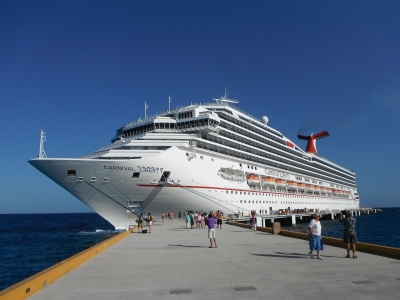
With the CDC's latest Covid-19 No-Sail order now extended through September 30, you're probably wondering if we'll ever enjoy a cruise again. It's difficult to believe it now, but ships will sail again, though it will most likely feel very different. Some smaller European cruise lines and those not under the Cruise Lines International Association (CLIA) umbrella, have already begun sailing with new policies in place. All other cruise lines - small, luxury, river and mainstream - are in the process of formulating new enhanced health and safety measures to earn the trust of their loyal customers when it's time to embark.
The new protocols won't be the same across the board for every cruise line, but at least some will be common to all, and apply to both guests and crew members. Cruisers should contact their specific cruise line in advance for the exact measures being implemented. Otherwise, it's safe to say that guests can expect at least some of the following items in place when boarding a ship while the world deals with the pandemic and awaits development of a vaccine.
Pre-Boarding Procedures
The on-line checkin most of us are accustomed to may become mandatory in order to reduce in-person contact at the port. A health questionnaire will be given to guests to complete prior to arriving to the ship, certifying they are in good health. This may include providing the cruise line with proof of Covid-19 testing. Staggered port arrivals may be implemented to reduce crowds, and temperature checks and a health screening will re required as well as baggage sanitizing. Clients with flu-like symptoms or who have tested positive for COVID-19 in the previous 30 days would be denied boarding.
Reduced Ship Capacity
You most likely will find fewer passengers on board. In most cases, guest capacities will be reduced, at least temporarily, in order to reduce pockets of crowding and encourage social distancing. Some small-ship or luxury lines with a high space ratio will keep their passenger capacity as is, believing their present public spaces are wide open enough to support social distancing.
Social Distancing
Cruise lines have plans in place to encourage social distancing including spacing out dining tables and theater seating. This strategy may be easily accomplished on small luxury and adventure ships, and by reducing the number of passengers on much larger vessels, guests can be assured that social distancing will be possible across all dining and public venues on board their favorite mega ships, as well.
Face Coverings
Given that face masks are currently a hot debate between faithful wearers and those who refuse, it's not certain which way the cruise lines will go on this issue. As a result, some lines have either said masks will not be mandated onboard, they will be encouraged, or that they are waiting to make a final decision closer to relaunch. If masks are required in public settings, it will be interesting to see how many comply and the consequences for those who don't. It will also be interesting to learn how many people refuse to cruise with a mask mandate in place. In any event, it's likely that masks will be required when traveling to and from the ship or while on shore tours.
Revised Dining
The most noticeable change cruisers may find once on board will be the absence of self-service buffets. Food and beverages at all restaurants, lounges and bars will be served to guests by crew members wearing masks and disposable gloves. For the time being, at least across most cruise lines, there will be a greater emphasis placed on full-service food delivery including convenient options for room service.
Sanitation and Filtration
Upholding high standards of cleanliness is not new to cruise ships, especially in recent years while combating norovirus. Now, with Coronavirus, cruise lines are taking it up a notch with the addition of medical-grade fogging and UV light to scrub ships beyond increased disinfection of high-touch surfaces. Cruisers can also expect to hear more about air filtration, HEPA-style purification systems, chlorine-cleaned cooling coil drains and water purification.
Naturally, guests must also do their part in thorough hygiene, so extra sanitizing stations and touch-less faucets are being added. As always, all guests will be strongly encouraged to engage in frequent hand-washing, including when entering food and beverage venues, and hand sanitizer will continue to be easily accessible throughout the ship.
Quarantine Zones
While the goal of these new health and safety measures is to prevent disease, cruise ships will nonetheless need to be prepared and will be increasing the availability of medical staff such as dedicated public health officers, equipment (including ventilators), treatments and facilities, as well as setting aside isolation cabins for quarantine as needed. This may include
care and evacuation to a local facility and onboard risk analysis that may lead to making a decision on the progress of a specific cruise.
Shore Excursions
Plans are also being developed for going ashore, especially staggering the disembarkation and re-embarkation of guests on excursions, screening their temperature upon return and reducing the capacity of disinfected tour busses and launches by half.
Post-Cruise
Recognizing the importance of COVID-19 contact tracing, some cruise lines have plans to set up a post-voyage notification process through which passengers and crew can notify the cruise line if they become unwell within 14 days of disembarkation (the COVID-19 incubation period).
_____________________________
By Janice Neves, CruiseCrazies Authorized Agent; Photo Credit (Unsplash Stock)












Recommended Comments
There are no comments to display.
Join the conversation
You can post now and register later. If you have an account, sign in now to post with your account.